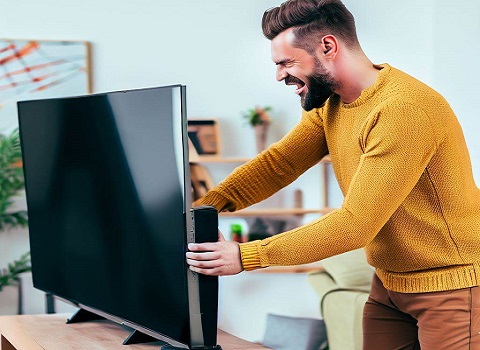Connecting a non-smart TV to WiFi might seem daunting, but with a few simple steps, it is entirely possible. The process will vary depending on your TV and the available equipment, but in this guide, we will cover the basic steps you need to follow to connect your non-smart TV to WiFi.
Before we dive into the steps, let’s discuss why you might want to connect your non-smart TV to WiFi. One of the primary reasons is to access online streaming services like Netflix, Hulu, Amazon Prime, or YouTube. By connecting your TV to the internet, you can access these services and watch your favorite shows and movies without additional equipment.
Another reason to connect your non-smart TV to WiFi is to enable screen mirroring or casting. Screen mirroring allows you to display the content of your phone, tablet, or computer screen on your TV, while casting allows you to stream content from your phone or computer directly to your TV.
Now that we’ve covered some reasons you might want to connect your non-smart TV to WiFi let’s dive into the steps.
Check if your TV has an Ethernet port
The first thing you need to do is check if your TV has an Ethernet port. This port looks like a larger version of a phone jack and is usually located on the back or side of your TV. If your TV has an Ethernet port, you can connect it directly to your router using an Ethernet cable. This method is the most reliable and will provide a faster and more stable connection than WiFi.
Check if your TV has a built-in wireless adapter
If your TV does not have an Ethernet port, the next step is to check if it has a built-in wireless adapter. Some older models of TVs come with a built-in wireless adapter that allows them to connect to WiFi networks. To check if your TV has a built-in wireless adapter, refer to the user manual or check the TV’s settings menu.
Purchase a wireless adapter
If your TV does not have a built-in wireless adapter, you must purchase an external adapter. These adapters, also known as WiFi dongles or wireless bridges, can be found at most electronics stores or online retailers. Make sure to purchase an adapter compatible with your TV’s brand and model.
Connect the adapter to your TV
Once you have purchased the adapter, the next step is to connect it to your TV. Most adapters connect to your TV’s USB port or HDMI port. If your TV has a USB port, plug the adapter into the port. If your TV does not have a USB port, you must use an HDMI adapter to connect the wireless adapter to your TV.
Connect the adapter to your WiFi network
Once the adapter is connected to your TV, you must connect it to your WiFi network. To do this, you will need to follow the instructions that came with the adapter. In most cases, you must go to your TV’s settings menu and select the option to connect to a WiFi network. You will then need to select your network and enter your WiFi password.
Test the connection
Once you have connected your TV to your WiFi network, you should test the connection to ensure it works correctly. You can do this by opening a streaming app or website on your TV and checking if the content loads correctly.
Set up screen mirroring or casting (optional)
If you want to use screen mirroring or casting, you must set it up on your TV. The process will vary depending on your TV and the device you are casting from, but in most cases, you will need to go to your TV’s settings menu and select the option for screen mirroring or casting. Then, on your phone or computer, you must select the option to cast or mirror your screen and select your TV as the device to cast or mirror too.
Tips for a Better WiFi Connection
Now that you know how to connect your non-smart TV to WiFi, let’s review some tips to help you get the best possible connection.
- Position your wireless adapter correctly: If you are using an external one, make sure to position it in a place where it can get a strong signal from your WiFi router. Avoid placing it behind your TV or where other objects block it.
- Upgrade your router: If you are experiencing a slow or unstable WiFi connection, consider upgrading your router. A newer router with better technology will provide faster and more reliable WiFi.
- Reduce interference: WiFi signals can be disrupted by other devices, such as microwaves, cordless phones, or other electronic equipment. Keep these devices away from your TV and router to reduce interference.
- Use a WiFi extender: If your TV is far from your router, consider using a WiFi extender to boost the signal.
- Limit the number of devices connected to your network: The more devices connected to your WiFi network, the slower the connection will be. Try to limit the number of devices connected to your network to improve the speed and stability of your WiFi.
Conclusion
Connecting a non-smart TV to WiFi is easier. The steps are simple whether your TV has an Ethernet port or requires an external wireless adapter. By following the steps outlined in this guide, you can enjoy online streaming services and screen mirroring or casting on your non-smart TV. With a few tips for improving your WiFi connection, you can ensure that you get the best possible experience when using your TV to access online content.
Frequently Asked Questions (FAQs)
What is an external wireless adapter, and how does it work?
An external wireless adapter, also known as a WiFi dongle or wireless bridge, is a device that allows you to connect your non-smart TV to a WiFi network. It works by receiving a wireless signal from your WiFi router and converting it into a signal your TV can understand.
What is the difference between screen mirroring and casting?
Screen mirroring and casting are two ways to display the content of your phone or computer screen on your TV. Screen mirroring displays an exact replica of your screen on your TV, while casting allows you to stream content from your phone or computer to your TV without displaying your entire screen.
Can I use a WiFi extender to connect my non-smart TV to WiFi?
Yes, you can use a WiFi extender to boost the signal to your TV if it is far from your router. A WiFi extender works by receiving the WiFi signal from your router and amplifying it to extend the range of your WiFi network.







